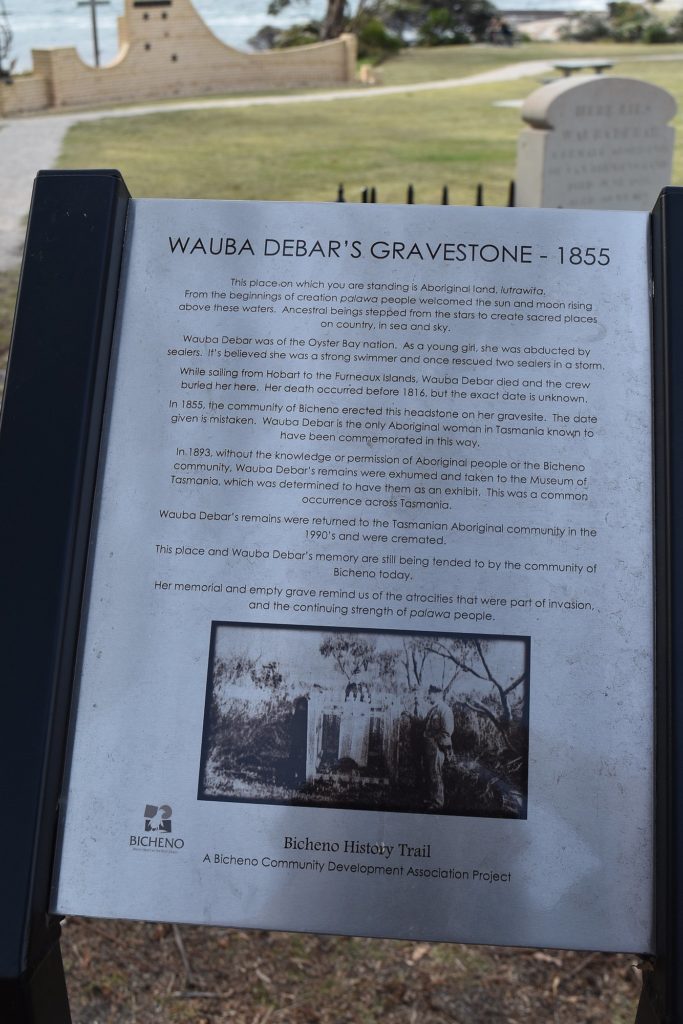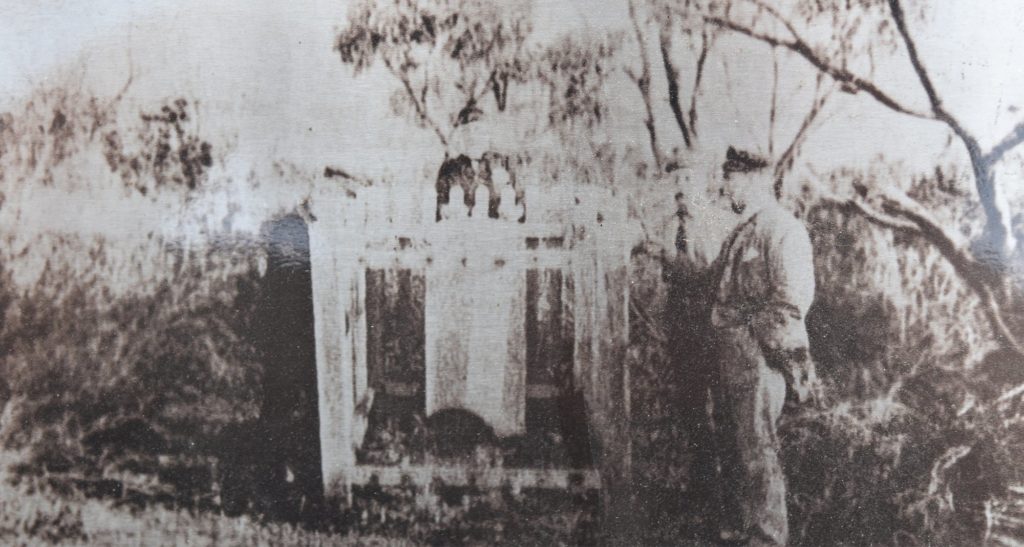In Bicheno, in a little park overlooking Waubs Bay, you’ll find a lonely, and empty, grave.

HERE LIES WAUBADEBAR
A FEMALE ABORIGINE OF VAN DIEMENS LAND
DIED JUNE 1832
AGED 40 YEARS
This Stone is Erected by a few of her White friends

WAUBA DEBAR’S GRAVESTONE – 1855
This place on which you are standing is Aboriginal land, lutrawita. From the beginnings of creation palawa people welcomed the sun and moon rising above these waters. Ancestral beings stepped from the stars to create sacred places on country, in sea and sky.
Wauba Debar was of the Oyster Bay nation. As a young gin, she was abducted by sealers. It’s believed she was a strong swimmer and once rescued two sealers in a storm. While sailing from Hobart to the Furneaux Islands, Wauba Debar died and the crew buried her here. Her death occurred before 1816, but the exact date is unknown.
In 1855, the community of Bicheno erected this headstone on her gravesite. The date given is mistaken. Wauba Debar is the only Aboriginal woman in Tasmania known to have been commemorated in this way.
In 1893, without the knowledge or permission of Aboriginal people or the Bicheno community, Wauba Debar’s remains were exhumed and taken to the Museum of Tasmania, which was determined to have them as an exhibit. This was a common occurrence across Tasmania.
Wauba Debar’s remains were returned to the Tasmanian Aboriginal community in the 1990’s and were cremated.
This place and Wauba Debar’s memory are still being tended to by the community of Bicheno today. Her memorial and empty grave remind us of the atrocities that were part of invasion and the continuing strength of palawa people.

Photo from panel
WAUBA DEBAR was, as the inscription on her gravestone runs, “a female aboriginal of Van Diemen’s Land,” who “died June, 1832, aged 40 years.” Little is known of Wauba Debar’s history before death, but the story of the disposal of her mortal remains , has a touch of the romantic about it. It appears that Wauba Debar was sailing from Hobart to the Straits Islands on a sealing expedition, when her spirit was called to join those of her forefathers in the happy or unhappy hunting grounds, whither they had fled before, according to their deserts. The crew humanely interred her at Bicheno, the death having occurred off either Maria or Schouten Islands, and of course no one was living near at the time. Very old residents fix the exact date to the interment at ten years before the time on the recording stone. One of them recollects when the headstone and railing were erected by public subscription, the spot having been previously marked by a slab of wood, bearing some particulars. But as it was not decided to honour Wauba Debar with a modern monument till some years after her burial, it was necessary to make sure that the wooden slab covered the exact spot. And then it was that Wauba Debar’s bones were’ subjected to their first disturbance. A local Jerry Cruncher was found, and all doubt was removed when the bones were exhibited. They were then replaced and a railing fence was put up and a footstone added bearing the monosyllable “Waub.”
Thence onwards down till a few weeks ago Wauba Debar’s bones lay undisturbed in the little grave on the Esplanade at Bicheno, within 50 or 60 yards of high water mark. The death of Truganinni in 1876 meant the departure of the last of her race, and aboriginal remains are becoming more scarce, and of course their value has gone up correspondingly. So when the Museum people heard about Wauba Debar it was determined to secure her if possible, and a price was, so to speak, put upon her head. The resurrection arrangements were completely made and successfully carried out. Wauba Debar was found to be in her old place, where she was put some 70 years previously, only the first exhumation had caused her to present a somewhat disordered appearance on this second exhumation. Everything that the watery grave, with a gravelly bottom was able to give up was put into a box, securely packed, labelled “Native Currants,” and despatched by the Warrentinna to the metropolis. Soon afterwards the local Municipal Council heard about the rise and flight of Wauba Debar, and felt aggrieved that the wishes of the inhabitants had not been consulted, and decided to see what power they exercised over the grave and its contents.
But it appears that the law takes no account of a person after death, unless he or she is wearing clothes, and then there is a legal value in the garments. And as nobody could be found to prove that Wauba Debar wore clothes when she was despatched to the Museum, it is quite probable that no claim on her could be sustained, and that she will continue to occupy the comfortable quarters provided for her in a glass case alongside the remains of others of her race, where she will be a subject of interest for all time, a distinction she could not possibly have attained by continuing her secluded residence at Bicheno.
The Mercury, 16 September 1893
The answer which the Minister of Lands has chosen to give to the communication from the Glamorgan Council, in reference to the removal of the remains of the aboriginal woman, Wauba Debar, from their grave on the beach at Bicheno, can hardly be regarded as in accord with that gentleman’s reputation for humanity and kindly feeling. It may not, as he says, be Mr. Hartnoll’s business to remedy this heartless piece of body-snatching, but he might, at least, have pointed put to those who approached him where their remedy lay. As it is, the presence of these few poor bones, and the hopelessly grinning skull, which have been buried in the earth for over 70 years, in the glass show case at the Museum, is a grave scandal to the community. One has only to look at what the results of long interment have left of the skeleton to at once perceive what a mockery it is to say they have been extracted from their last resting place in the cause of science. They display all the ravages of time, and set as they are alongside other aboriginal remains there is additional evidence that science could have been perfectly satisfied with what it had already obtained, without their acquisition.
[continued]
The Mercury, 21 September 1893

Waubs Bay
